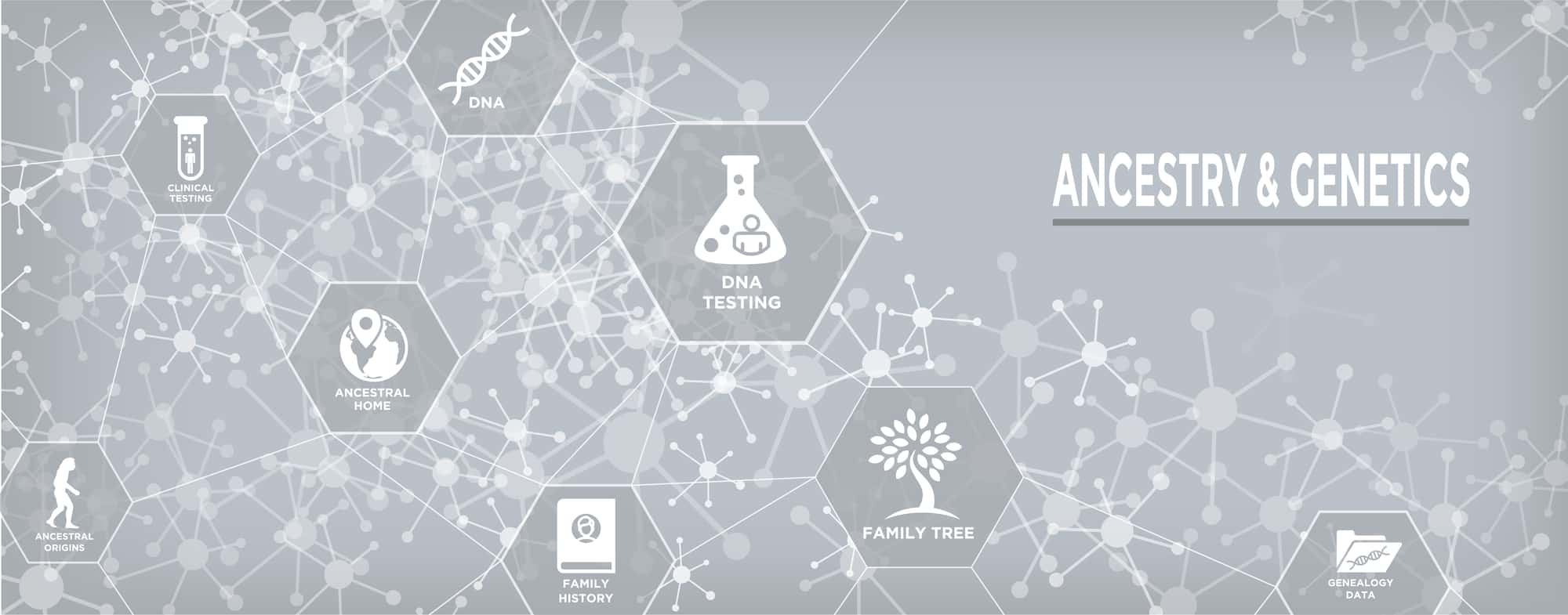In this guide, we explore the practical and scientific aspects of genetic genealogy. From understanding different genealogical DNA tests to exploring the role of this field in studying population genetics and human migration, we cover a range of topics that offer insights into the use of DNA in tracing ancestry.
What is Genetic Genealogy
Genetic genealogy combines DNA testing with traditional genealogical methods to identify biological relationships and trace ancestral lines. This approach allows individuals to uncover their ethnic background, identify genetic traits and find relatives they may not have known existed.
As DNA testing has become more accessible and affordable, the popularity of genetic genealogy has surged, becoming a go-to solution for people keen on understanding their heritage and assessing genetic markers linked to various traits and disease risks.
Genealogical DNA tests
Genealogical DNA tests are used in genetic genealogy to help determine your ancestry and genealogical origins. These tests compare the results of a DNA test with those already tested by others in order to determine genetic similarities and provide information about how closely people are related. Tests are conducted using DNA samples, typically from a cheek swab or saliva.
Genealogical DNA testing companies
There are several companies that offer DNA testing for genetic genealogy, including:
These companies use a variety of techniques and approaches to analyze DNA samples and provide information about a person’s ancestry and family history.
Types of DNA tests
There are three main types of genealogical DNA tests: autosomal (atDNA), mitochondrial (mtDNA), and Y-chromosome (Y-DNA).
Autosomal DNA testing is useful for finding relatives within the past five to seven generations, and can help people learn more about their ethnic ancestry.
Mitochondrial DNA testing looks at the DNA found in the mitochondria, and can be used to trace a person’s direct maternal ancestry.
Y-chromosome DNA testing examines the DNA found on the Y chromosome, which is passed down from father to son. These tests are useful for tracing a male’s direct paternal ancestry.
Population Genetics
Population Genetics is a branch of genetic genealogy that studies the different frequencies in which DNA occurs in a population. This is usually done by sampling different genomes in the population, such as blood samples or cheek swabs.
Biogeographical origin (ethnicity) can be predicted using computer algorithms and proprietary calculations to estimate what percentage of an individual’s DNA comes from particular ancestral groups. This can be a really interesting way to learn more about your family history and where you come from.
Investigative Genetic Genealogy
Investigative Genetic Genealogy is a method of using genetic genealogy to discover unknown identities. It is named for the investigative branch of law enforcement, but is not a form of forensic science, nor does it have anything to do with crime scene investigation or criminal prosecution.
The main difference between IGG and forensics is that IGG relies on public information from databases and genealogical research, while forensics uses material from crime scenes that has been analyzed in a lab. IGG can help law enforcement solve violent crimes and cold cases, as was the case with the Golden State Killer.
Human Migration
Human Migration can be studied in genetic genealogy with the use of haplogroups. A haplogroup is a genetic population that shares a common ancestor. When different populations migrate, they often take their haplogroups with them. Therefore, the distribution of haplogroups tends to show the spread of human migrations through time and space.
Most recent scientific studies on genetics have indicated that humans originated in Africa, about 300 thousand years ago.
Whole Genome Sequencing
Whole genome sequencing used to be a costly and time-consuming process. However, thanks to advances in technology, whole genome sequencing is now more affordable and accessible than ever before. This technology can provide invaluable insights into an individual’s health, ancestry, and risk of developing certain diseases.
Whole-genome sequencing is an important tool for researchers who are working to improve our understanding of human health and disease. As more people have their genomes sequenced, we will gain new insight into the complexities of the human genome and how it affects our health.
FAQ
How does genetic genealogy work?
Genetic genealogy uses autosomal DNA single nucleotide polymorphisms to discover recent common ancestors between two or more people. This is done by examining the SNPs on your chromosomes and comparing them to other people’s chromosomes. If two people share a long stretch of DNA, it is likely they share a common ancestor.
What type of DNA is needed for genetic genealogy?
Autosomal DNA is the most common type of DNA used in genetic genealogy. Autosomal DNA is found in the 22 pairs of chromosomes that don’t contribute to sex and gender and can be used to find biological relationships (of all kinds) through DNA.
What is the purpose of genetic genealogy?
The purpose of genetic genealogy is to use DNA testing to discover ancestry and relatives. It can be used to explore your family tree and learn about your genetic heritage. It can also be used to find biological parents, siblings, and other close relatives.
How can I learn genetic genealogy?
There are many ways to learn genetic genealogy. One of the best ways to learn is to find a good online course. There are many courses available, and most of them are very affordable. Another great way to learn is to join a local genealogy society. They often offer workshops and classes on genetic genealogy. You can also find many helpful articles and videos online, especially on this website!




I found a match through dna saying that I have a half sister or niece. We share 20%: 1384 cm across 50 segments. We were both adopted but have since discovered that our mothers were sisters. Does that mean are fathers were related too or we share the same father?
Hey John. Hard to say without more info, but 1384cm is still within range for a first cousin relationship. It’s at the high end but within range.